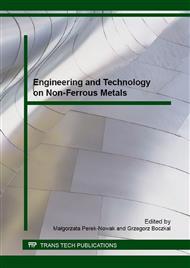[1]
V. Danchenko, H. Dyja, L. Lesik, L. Mashkin, A. Milenin, Technologia i modelowanie procesów walcowania w wykrojach, Częstochowa 2002, ISBN 83-87745-66-9, 540-567.
Google Scholar
[2]
ASM Handbook, Aluminium and Aluminium Alloys, ASM International, (1993).
Google Scholar
[3]
H. Wiśniewska-Weinert, J. Borowski, J. Sulej-Chojnacka, D. Andrzejewski, Mechanical properties of TIG welded extruded aluminium profiles of 5xxx and 6063 alloys, VI Mezhdunarodnyj Kongrecc Cvetnye Metally i Mineraly - 2014 razdel XI, Obrabotka Metallov Davleniem, 1201-1206.
Google Scholar
[4]
D. Leśniak, A. Rękas, W. Libura, J. Zasadziński, Badania odkształcalności stopów serii 5xxx o wysokiej zawartości Mg w procesie półprzemysłowego wyciskania, Obróbka Plastyczna Metali, 25 (2014) 159-167.
DOI: 10.15199/67.2016.6.3
Google Scholar
[5]
T. Shepard, On the relationship between extrusion conditions, mechanical properties and surface acceptability in some hard aluminium alloys", Proc. 7th International aluminium extrusion technology seminar, Chicago 2000, 307-320.
Google Scholar
[6]
A. Henzel, T. Spittel, Rasciet energosilovykh parametrov v processakh obrobotki metallov davlenijem, Metalurgija, Moskva, 1982, (in Russian).
Google Scholar
[7]
K. Laber, Określenie własności reologicznych wybranych gatunków stali do spęczania na zimno w próbie skręcania, Hutnik-Wiadomości Hutnicze, 82 (2015), 238-342.
DOI: 10.15199/24.2015.5.5
Google Scholar
[8]
F. Grosman, E. Hadasik, Technologiczna plastyczność metali. Badania plastometryczne, Wydawnictwo Politechniki Śląskiej, ISBN 83-7335-204-X, Gliwice 2005, 11-12.
Google Scholar
[9]
P. Szota, S. Mróz, A. Stefanik, R. Mola, Analysis of the AZ31 magnesium alloy bars rolling process in modified stretching passes, Materialwissenschaft und Werkstofftechnik, 46 (2015) 285-293.
DOI: 10.1002/mawe.201400349
Google Scholar
[10]
J.L. Chenot, L. Fourment, T. Coupez, R. Ducloux, E. Wey, Forging and Related Technology, Birmingham, 1998, 113.
Google Scholar
[11]
A. Gavrus, E. Massoni, J.L. Chenot, An inverse analysis using a finite element model for identification of rheological parameters, Journal of Materials Processing Technology, 60 (1996) 447-454.
DOI: 10.1016/0924-0136(96)02369-2
Google Scholar


